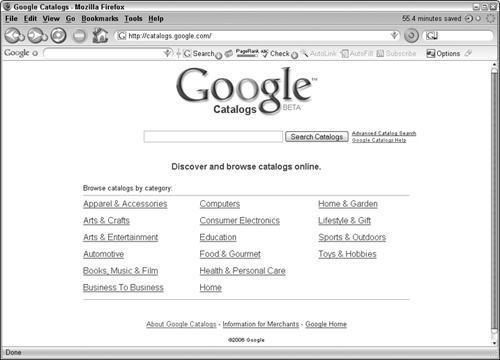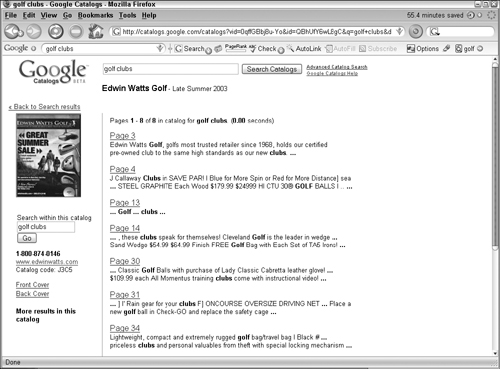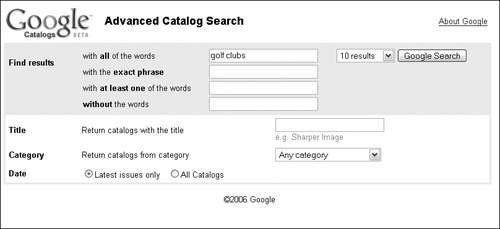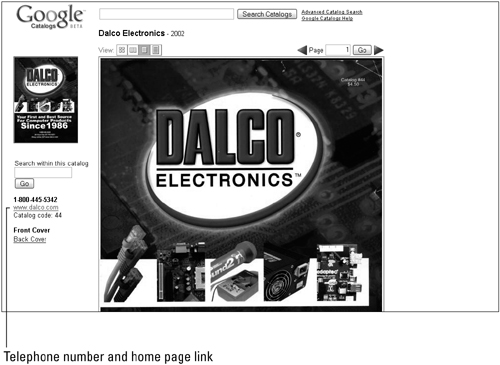Learn to search through online Catalogs
Advanced searching through the catalogs
Navigating catalogs with Google’s special interface
Get your catalog online with Google Catalogs
It may not be as fun, or as creatively useful as the old Sears catalog, but Google has created a streamlined and common way you can search the catalogs of many online vendors. This way you don’t have to figure out where and how to navigate through the many kinds of online catalogs. You can do all your searching in a single place.
Google has scanned catalogs from partner vendors. You can see the vendor’s fullcolor catalog online in an easy-to-browse format. You can navigate to the vendor’s home page and have the catalog right at your fingertips. You can also use some of the other Google shopping tools such as Froogle to comparison shop by switching back and forth between Froogle and Google Catalogs. You may find vendors that you never knew existed have exactly what you’re looking for.
Browsing through catalogs gives you an entirely different experience than many e-commerce sites that try to get you to the page where you click the Buy button. Catalogs make you familiar with a company’s entire line of products. You may find companion products or models that are superior to the product you had in mind. You might just enjoy browsing catalogs without the intention of buying anything. For example, many hobbyists browse catalogs to keep up with the latest gadgets and things of interest.
Start searching through Google Catalogs by navigating to http://catalogs.google.com. This launches a Web page that serves as a portal to hundreds of online catalogs (see Figure 7.1). Find the category of item you are searching for among the 16 links, or use the search box at the top of the page. Using the search box may speed up your search by letting you type the name of the item you want to purchase, or it may slow you down by returning items in categories not related to the item you want. You will have to try your search; if you need to browse the catalogs, you may find that more effective and possibly more fun.
The interface for browsing catalogs is simple. Click one of the major catalogs from the main Google Catalogs page. For example, clicking the Computers link displays vertical columns. The right column contains thumbnails of catalogs and brief descriptive information, such as the catalog name, when it was published and direct link to the vendor’s homepage.
The left column displays the category selected, and the previous level above and below any subcategories. In the example of clicking on the Computers category, the previous level is All Categories and the subcategories are Software, Systems & Accessories, and Windows. You can choose to browse through all the related catalogs in the right pane or select a subcategory to further focus your search. You can see in the upper-right corner of the page how many catalogs Google found for the category you selected.
Typing search terms in the Catalog search box is similar to any other Google search. Type the name of the item, the brand, or category of item you are searching for, and a list of catalogs appears, as shown in Figure 7.2. In the example shown in this figure, the search term golf clubs is typed. A list of catalogs, with the cover of the catalog displayed on the left, appears in the search results.
The search results include the name of the catalog, when it was published, a description of the catalog and a link that allows you to see more results that include your search term within the catalog. Clicking this link gives you a list of the pages that contain your search term. Figure 7.3 shows the results page from within the catalog. Notice also in Figure 7.3 that you can search just within the catalog by typing your search terms into the search box in the column on the left of the results page.
For ease of purchasing, included in the left column of the catalog detail page is the telephone number and link to the vendor’s Web page. There is more about buying from a catalog later in this chapter.
When you find the catalog you want to browse through, it is displayed using the Web-based, Google Catalog Interface. The catalog interface includes a scanned view of the catalog in the center of your screen and links in the left column to scans of both the front and back cover of the catalog. You aren’t restricted to this view of the catalog. Google’s catalog interface provides four different views:
Multi-page view: This view allows you to see many pages of the catalog at the same time in thumbnail view. The thumbnail is large enough so that you may be able to use this view to quickly locate the item you are looking for within the catalog. Each page appears as a link so simply clicking on the thumbnail launches that page in Normal view.
Two page view: View two pages at the same time. This view is useful when reviewing a lot of information about a single item or comparing many different items.
Normal page view: This is the default view and displays a single page of the catalog.
Zoom view: When the catalog is a little too small to see, you need not go out and get laser eye surgery. Select Zoom view and see the catalog page just a little larger than the normal view.
Change among these four views by selecting from the icons that appear in the box labeled View: that appears above the upper-left corner of the catalog page shown in your browser window. It may be necessary, depending on your computer’s display settings, to use the left and right window scroll bars to see the entire scanned page. This is particularly true when using Zoom view.
While viewing the catalog, you will notice that your keywords or phrases found within the catalog are highlighted in yellow. This helps you quickly locate the item you searched for. Also, if you do not find the item, the items highlighted in yellow may help you figure out how to better focus your search using the Advanced Search features discussed later in this chapter.
The vendor may choose not to have Google scan certain pages in its catalog. This decision may be made for any number of reasons. The page is still “in” the catalog: You just can’t view it. Instead, an image stating “Image not available” appears in its place.
Navigate through the catalog by using the blue, left, and right arrow keys found above the upper-right corner of the catalog. The current page number or numbers are displayed between the arrows. The number of pages that increment or decrement changes depending on the view that is set. The Normal and Zoom setting change to either the previous or next page. The others change two or more pages at a time depending on the setting.
To access the Advanced Catalog Search, click the link next to the search box found near the top of nearly any Google Catalog page. When you click the Advanced Catalog Search link from a result page, your search terms appear automatically in the Advanced Catalog Search page in the “with all the words” box.
Setting the advanced search settings is similar to any other Google Web search. You can focus your search terms, as shown in Figure 7.4, by limiting your search to search results matching all your search terms, with an exact phrase, with at least one of the words within a list of words, or by limiting the search by excluding pages with a specified term or phrase.
Unlike other Google searches, the advanced search features allow you to search for a specific catalog title—for example, The Sports Authority. In the Return catalogs with the title box, type all or part of the name of the vendor who publishes the catalog. If you type part of a name, you may get more than one catalog with vendors that have similar names. For example, typing Sports will give you 1,340 results, of which The Sports Authority is only one. When you know the exact name of the vendor, you may also want to enclose the name of the vendor in quotes to better focus your search.
You can choose to focus your search by selecting a category for your search. These categories are similar to the ones listed on the main Google Catalogs page. Select one of the 16 different categories from the drop-down list. You can choose one. If you need to search on multiple categories, you may need to perform more one than one search, changing the catalog category each time.
The last advanced search criterion allows you to specify whether you want to see only recent catalogs or all catalogs by the different vendors. Of course, specifying all catalogs increases the potential number of search results but may show you old and out-of-date catalogs.
There is currently no way to purchase items in the various catalogs using a Google interface like the one used to purchase videos. In the event that you find the item you want to purchase, you need to contact the vendor either by calling the phone number provided on each of the Google catalog results pages for the vendor or by visiting the vendor’s Web site. That link is also provided on each of the catalog results. See Figure 7.5 for the location of the vendor information.
Note
Clicking on the vendor’s homepage link causes you to navigate away from the Google Catalogs pages. Use your browser’s Back button to return to your search results or you can right-click and choose Open Link in New Window, or simply Shift+click on the link.
Remember that items and prices within the catalog may have changed. Don’t depend on the prices you find in the catalogs to make your final decision. You may even decide to use Google’s Froogle application before purchasing to find and compare prices.
Cross-Ref
You can learn more about Froogle in Chapter 8.
In some cases, when ordering online you can refer to the optional catalog code listed in the left pane when speaking with a customer service representative. When this is available it will help you know that you are shopping from the most current catalog and the customer service representative may be able to refer to specific page numbers if he or she knows exactly what catalog you are shopping from. Generally, each item within the catalog will also have an item number making ordering or referring to an item much simpler.
Google is looking for a few good catalogs. Actually, it’s looking for many good catalogs and wants to partner with vendors to host their catalogs for free. The requirements for submitting a catalog include the following:
The catalog must be from a U.S.-based company.
The prices for each item must be printed in the catalog.
The catalog must be designed to assist people with making immediate purchases.
Items for sale must be legal in all 50 states.
When selecting catalogs to scan, Google may reject catalogs that are of an unusual size. This includes oversized catalogs or small, pocket-sized catalogs. Because of Google’s viewing interface, the catalog must also be oriented in portrait view, not the landscape view often used in automobile catalogs.
For now, at least, Google is not accepting catalogs in the following categories:
Non-U.S. catalogs
Travel brochures
Travel guides
Course catalogs from schools or private educational organizations
Manufacturing data sheets (single-page, sometimes printed both sides, informational sheet)
Before you can send Google your catalogs to be scanned, you must first sign up at services.google.com/catalogs/application and be approved as a vendor. Signing up is easy and consists largely of typing your company’s contact information and agreeing to the terms and conditions. Once your entry is accepted, you are sent by e-mail a specific address to which you should send your catalogs to be scanned.
If you are already a merchant with a catalog in Google Catalogs you may want to manage which catalog people see. To update your catalog with Google, simply send the new catalog to the special address Google provided when you became a vendor. If you’ve lost this address, you can always contact Google’s catalog services team at the e-mail address [email protected]. You can also write to catalog services at this e-mail address if you want to remove your catalog or change the description displayed with your catalog.
For more information, go to the Google Catalog Help page at http://catalogs.google.com/intl/en/googlecatalogs/help.html.
You may be wondering what Google gets out of hosting other people’s catalogs for free if it doesn’t take a percentage of the sale. Google, with its catalog-hosting service, forms relationships with vendors that will eventually use Google’s other merchant services such as Google AdWords and all the other services discussed in Part V of this book.
This chapter taught you how to search for and find items within a vendor catalog on the Google Catalog site. You can find catalogs by browsing or searching for catalogs using the familiar Google search box. Once you find a catalog, you can browse through it page by page or do keyword searches through the catalog itself, taking you right to the page that displays the items you’re interested in purchasing or simply interested in knowing more about.
If you are a vendor or merchant, Google lets you put your catalog online for free. If you meet the requirements you can use the power of Google to display your catalog online. Not only is this useful for small- to medium-sized businesses, but for larger companies as well. People use Google to find things, and having people find your product and buy it is probably why you are in business.
Several times in this chapter, we mention Froogle as a perfect companion to the Google Catalogs. Learn more about shopping with Froogle in the next chapter and see that it’s true that Google Catalogs is a great companion to Froogle.





